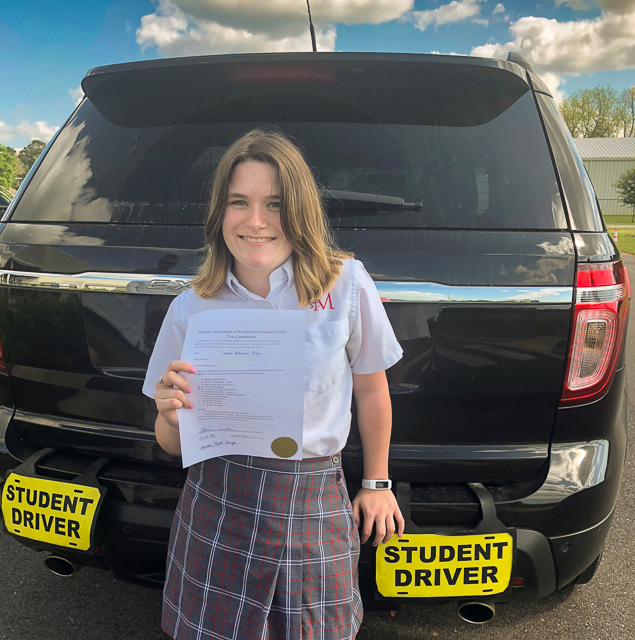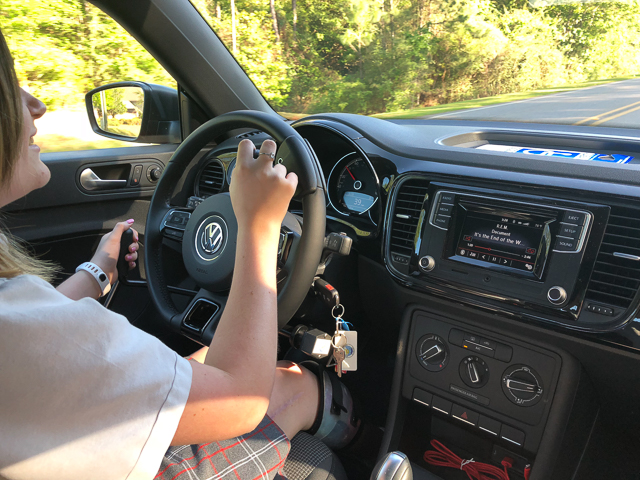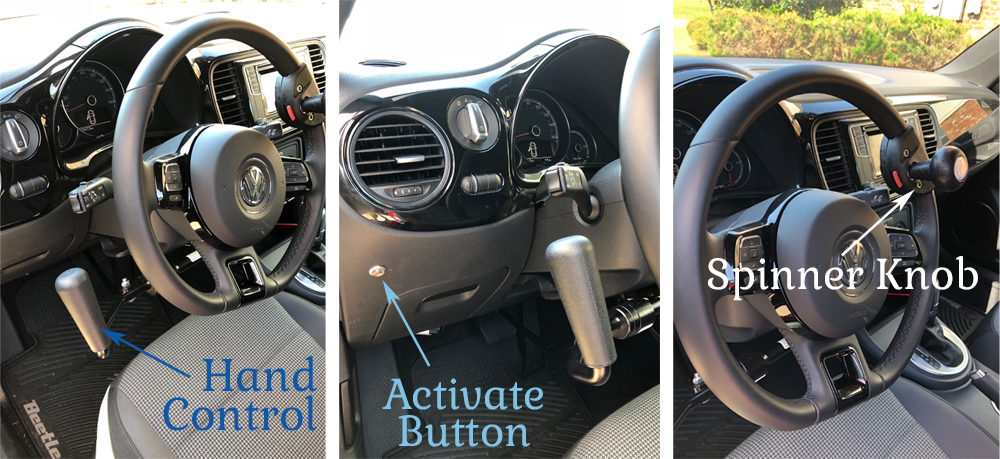If you follow me on Instagram you may have noticed that Sarah Kate is driving now AND that we bought her a brand new car (!!!) She won’t turn sixteen until the end of this year, and I’ll be honest – I’m not a fan of buying new cars for new drivers. As with most things, however, our family’s boots-on-the-ground reality as it relates to driving ended up being a little different from most people.
Although the process of actually learning how to drive was both simple and quick for Sarah Kate, the story of how we got to this point is a bit more detailed and complicated. When we first started looking ahead to the possibility of her learning to drive, I had a hard time finding any information about her options for training or equipment, and just from what little I’ve shared on social media, others are looking for this same information, so I thought a post series might be appropriate. Today’s post is Part Three; you can find Part One here and Part Two here.

Sarah Kate passed her adaptive driving test on Thursday, April 12, at the end of her third week of training. One day prior, her instructor gave me a heads up that she would be tested the next day, but he didn’t tell her, and I didn’t spill the beans. She didn’t know she was being tested until after she had passed. We said goodbye to Stephen, her instructor, and headed home to wait.
During the evaluation process, we had to fill out a lot of paperwork, and one of the items was a vendor request form. Once we chose a vendor to install the hand controls and Sarah Kate passed the driving test, ADRS sent a “prescription” to the vendor; Sarah Kate was prescribed a set of push-rock style electronic hand controls and a spinner knob. The vendor then ordered the prescribed controls (it took a little over a week for the controls to come in). We dropped the Beetle off at Team Adaptive in Mobile, which we chose based solely on a 30-second perusal of the company’s website, and got the car back the next day.
Before we left, the technician who did the installation took her for a spin around the block to make sure she was comfortable. I drove the car back across the bay (it was rush hour on the interstate) but got out and swapped with her once we made it across and let her drive the rest of the way home. Y’ALL. It was BIZARRE just getting out and letting her drive.

Push-Rock Hand Controls
The handle is mounted on the left-hand side of the steering wheel and is pushed away from the driver to apply the brake, and rocked back toward the driver to accelerate. For safety reasons, the brake works regardless of whether the hand controls are activated, but the accelerator works ONLY if the controls are activated. To activate the controls, the driver pushes a button right after starting the ignition of the car; if the button isn’t pressed the car automatically defaults to standard operation mode. The only difference a typical driver would notice is the presence of the controls themselves. I can still easily drive using my feet as in our other vehicles.
The hand controls can also be activated (or deactivated) while the car is running – Sarah Kate and I do this every day when going to and from school. She drives herself to school so when we pull up to the school, I swap over to the driver’s seat and then push the button three times in quick succession. The same thing happens in the afternoon; when she gets to the car it’s usually running (it’s hot here so Nathan and I need air conditioning!) so when she climbs into the driver’s seat she pushes the button to activate the controls before pulling away.
Spinner Knob
The spinner knob is mounted at the 2 o’clock position on the steering wheel and its purpose is for her to be able to make turns with only one hand (recreational boats often have a similar feature for the same reason). Experienced drivers don’t always need spinner knobs, but Sarah Kate definitely does! The knob can get in the way for a driver who isn’t accustomed to it because it sticks out a few inches from the steering wheel, but it pops off with a quick press of a release button if necessary. I popped it off when I drove the car the first day or two, but since then I’ve used it myself and to be honest, I really like it!
Sarah Kate is still trying to figure out the most effective way to use the hand controls and at the same time use other features, like turn signals. Her stereo can be controlled through buttons on the steering wheel, but for the most part right now she either has me change the channel/skip the next song/turn up the volume or waits until she’s stopped at a traffic light to do it. She absolutely can not text and drive – it’s simply not possible! – which is a blessing.

Cost, But With Caveats
I won’t begin to guess what the costs are for hand controls in different markets around the country, but when I first began researching hand controls I couldn’t find ANY reliable information about cost, so I’m going to share our experience in hopes of helping others. Adaptive equipment is never cheap, as I’ve mentioned many times before, and hand controls are no exception. But to be honest, I expected them to be more expensive (considering what they do), and considering how much money we (used to) spend every year on therapy for Sarah Kate, it seemed like a small price to pay for independence. I’m sharing the costs with you here so you’ll have some idea of how to prepare (keeping in mind that different drivers have different needs and every piece of equipment that must be added or upgraded incurs an additional cost).
Our total cost for the equipment was about $1600; approximately $200-300 or so of the total was the spinner knob and the rest was the hand controls. The equipment CAN be moved to another vehicle in the future, so she won’t necessarily have to incur that cost every time she changes cars. Team Adaptive suggested that the cost for a re-installation would fall in the $200-ish range (if done today…we don’t plan to do it any time soon).
Paying for Adaptive Mobility Equipment
If Sarah Kate was already sixteen, we could have gone to get her license right away and the cost of the controls would (probably) have been covered by ADRS. However, ADRS wouldn’t pay for her controls until she was licensed by the state of Alabama – even though per their internal jargon she has already “been licensed” by them because she passed the driving test. (YES, it’s frustrating and perhaps a bit discriminatory but I guess they feel the policy is justified because driving is a privilege, not a right? Also…the only car tags NOT available as vanity plates in our state are…disability tags. Of course.)
I’m sure the rules vary from state to state, but definitely check with your state department of rehab services before going out of pocket for hand controls. We could have waited until after her next birthday to apply and (possibly) not have had to pay for the hand controls out-of-pocket, but in the meantime she wouldn’t have been able to practice driving…for eight months.
However, as I mentioned in Part One, a number of the major auto manufacturers offer rebates on the purchase and installation of mobility equipment. Since the Beetle was new, we were eligible for the rebate. Note that these rebates are through the manufacturers, not the dealers, so the rebate is not part of the negotiation to purchase the car. We simply had to ask the dealer to sign the paperwork for us and mail it in. A total out-of-pocket cost of $600 seemed worth it to have her practice driving with one of us for several more months before being turned loose on the roads (rather than finishing training and then potentially forgetting everything she learned while waiting for her birthday to come ‘round).
So there you have it – our experience in being evaluated for, learning to drive with, and obtaining hand controls. I hope it’s been informational for those who may need (or have a family member who may need) adaptive mobility equipment in the future.
Of course, your mileage may vary. 😉
Note: I had hoped to include a video of Sarah Kate actually operating the hand controls, but both kids have been sick this week and it simply didn’t happen. I’ll work on getting it up soon.

Thanks for writing about your experience in the wonderful world of teaching your kids to drive, lol. I have two kids (without disabilities) one of whom just got his license a few months ago and the other can get his permit near the end of the year. The surreal-ness of them driving is the same no matter what the situation. I was wondering though, does Alabama not have a requirement for practice hours? In my state, once a kid gets a learners permit, they need to drive 60 hours (10 at night) and have the permit for 9 months before they can get their license. It sounds like because of your daughter’s age, she will get plenty of hours, but if I am reading correctly, if she was old enough, she would have her license after only 3 weeks? Just curious is all.
In Alabama you have to EITHER complete a set number of hours OR complete a state-approved driver education course. Her adaptive driving training qualifies as the latter. Most adaptive driving training (for new drivers, anyway) lasts longer than three weeks – she was ahead of the curve because she had already practiced driving a conventional vehicle in an empty parking lot a number of times and has been driving an off-road golf cart on my parent’s property for years.